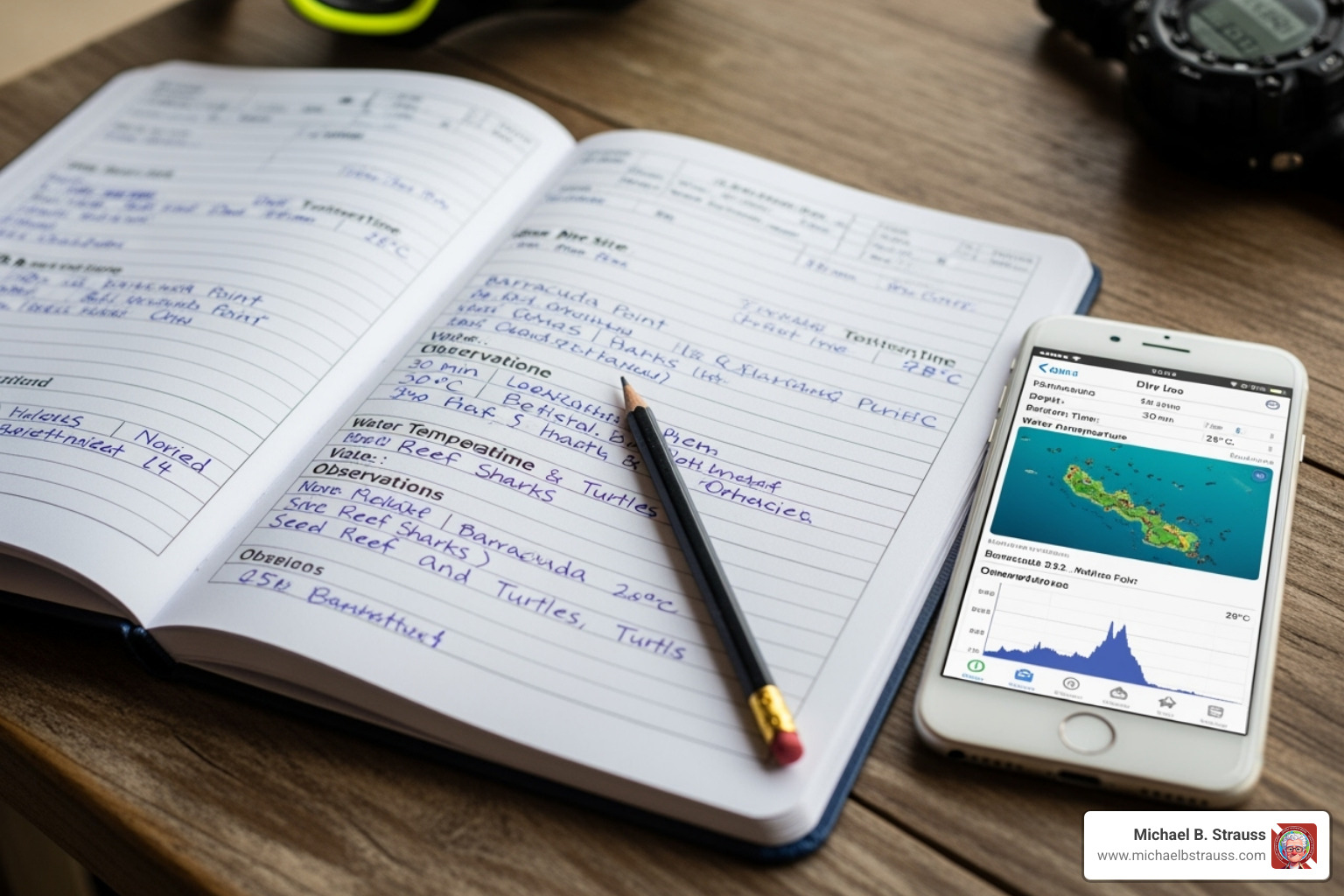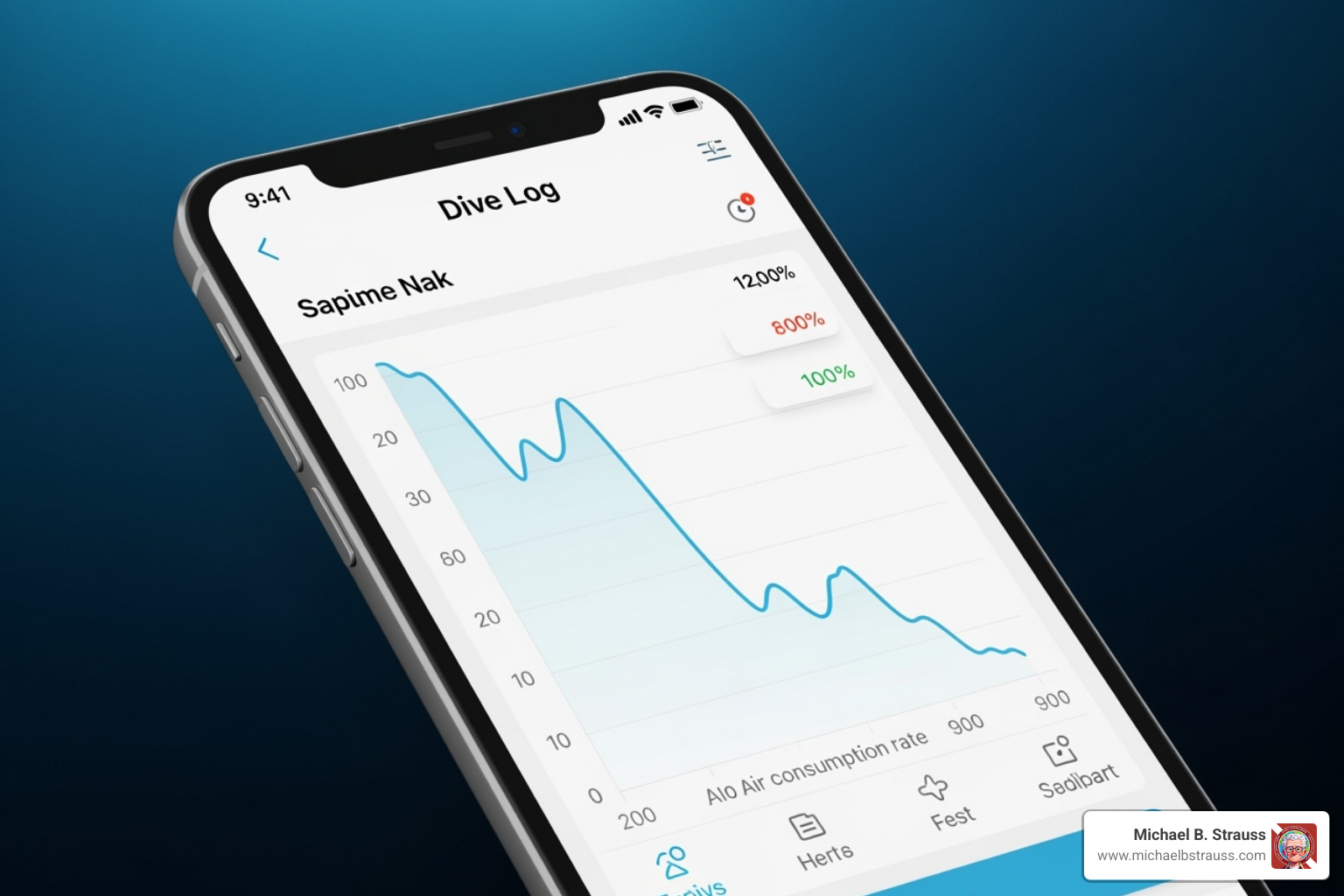More Than Just a Diary: Understanding Your Divers Log
A divers log is your underwater passporta detailed record of every dive that tracks your experience, skills, and safety data. It's a personal journal, technical document, and memory album rolled into one. But why is it so essential?
First, its an invaluable safety tool. Recording dive details creates a reference point for understanding your limits and equipment performance. In a diving incident, a detailed log provides crucial information for medical professionals, aiding in the diagnosis and treatment of conditions like decompression sickness (see Decompression sickness for a general overview). As expert Dr. Michael B. Strauss emphasizes, understanding your personal physiological responses is paramount, and a log provides a direct link to this data. Learn more in [Evaluation and Management of Pain-Related Medical Problems of Diving](https://www.michaelbstrauss.com/post/evaluation-and-management-of-pain-related-medical-problems-of-diving) and [Decompression Science](https://www.michaelbstrauss.com/post/decompression-science).
Second, a log acts as undeniable proof of experience. For advanced courses, gear rentals, or specialized dive trips, verified log entries are your credentials. It's also a powerful performance tracker for analyzing air consumption and refining buoyancy, helping you become a safer, more efficient diver. Finally, it's a memory aid to capture unforgettable encounters and relive your underwater journey.

The Evolution of Logging: From Paper to Pixels
Dive logging has evolved from traditional paper notebooks to sophisticated digital platforms. While physical logbooks offer a tangible connection to your dives, the digital revolution has transformed how we interact with our data.
The key is dive computer synchronization. Many modern computers can directly upload dive profiles to software or apps, eliminating manual entry and reducing errors. Digital logs offer powerful benefits:
- Cloud storage backs up your dive history and makes it accessible anywhere.
- Advanced data analysis generates charts and statistics to visualize your progress.
- Social sharing features connect you with buddies for verification and sharing experiences.
Whether you prefer the feel of pen on paper or the convenience of a smartphone app, the goal is the same: to create a comprehensive and meaningful record of your underwater journey.
The Anatomy of a Comprehensive Divers Log
This section details what to record and the different formats available, helping you build a complete and useful record of your underwater adventures.
Core Information for Every Divers Log
A valuable log entry transforms a simple note into a powerful safety and memory tool. While personal touches are great, certain core information is foundational.

- The Basics: Dive number, date, location, and specific dive site name.
- The People: Your buddy's name and any instructor or divemaster present for verification.
- Safety Data: Maximum depth, bottom time, and surface interval time are non-negotiable for safe planning.
- Environmental Conditions: Water temperature and visibility help you prepare for future dives in similar locations.
- Equipment Details: Record your weight used, equipment configuration, gas mix (Air/Nitrox), and start/end tank pressure to track performance and air consumption.
- Post-Dive Notes: This is where data meets experience. Note marine life sightings, skills practiced, or challenges like currents.
- Verification: Signatures and stamps from instructors are invaluable for advanced certifications.
Physical vs. Digital Logs: Choosing Your Method
Your logging method should match your diving style. Both traditional paper logs and modern digital apps have unique advantages.

Physical logbooks offer a tangible connection to your memories. They don't need batteries and are easy for instructors to sign. However, they can be bulky and make data analysis difficult.
Digital logging revolutionizes data interaction, primarily through dive computer synchronization. This automates data entry for depth, time, and more, providing detailed and accurate records. Digital platforms also offer powerful data analysis, cloud storage for backup, GPS tagging, and photo/video integration. Many divers use a hybrid approach, using a physical book for on-site notes and signatures and a digital platform for long-term storage and analysis.
For deeper insights into the science behind your diving experiences, explore More info about Diving Science.
Special Considerations for Advanced Diving
As you advance, your log must evolve to manage increased risk.
- Technical Diving: Your log becomes critical safety equipment. It must capture decompression stop schedules, gas switch protocols, and bailout plans. Understanding the body's response to extreme environments is crucial, a topic explored in Dr. Michael B. Strauss's research on Mammalian Divers.
- Freediving: Logs focus on breath-hold durations, warm-up routines, and recovery breathing patterns to help safely improve performance.
- Cave/Wreck Penetration: In overhead environments, logs must include line deployment details, navigation references, and conservative gas management calculations.
These advanced logs are essential tools for planning, analysis, and continuous skill improvement in challenging environments.
Leveraging Your Log for Safer, Better Diving
A well-maintained log is a powerful tool. Learn how to use your data to improve your skills, plan future trips, and improve your overall safety in the water.
Analyzing Data to Track Your Progress
Your divers log becomes a personal diving coach when you analyze the data. The most valuable metric is your air consumption rate (SAC or RMV). Tracking this over time shows your progress from a novice's rapid breathing to the relaxed consumption of an experienced diver.

Similarly, tracking your buoyancy control progress—noting weight requirements and performance—tells a story of developing skill. You can also monitor equipment performance to proactively service gear. Digital logs excel here, often generating charts that provide visual proof of your growing expertise. Each entry builds a compelling narrative of your journey from beginner to confident diver.
Planning Future Dives with Past Data
Your log is a crystal ball for future adventures. By referencing past dives, trip planning becomes far easier. Use your data to:
- Select exposure suits: Check water temperature records to choose the right thermal protection.
- Determine weight requirements: Replicate perfect weighting by checking what you used with specific gear configurations.
- Predict conditions: Use notes on currents, visibility, and marine life to set realistic expectations for return visits.
- Choose dive sites: Your log is a personal "greatest hits" collection that can inspire future travel.
Approaching a new adventure armed with the wisdom from your logged dives is the key to a successful trip.
The Role of Your Divers Log in Certification and Safety
Your divers log is both your diving passport and your safety net. It provides the proof of experience required for advanced courses and allows dive operators to verify your skill level. Instructor signatures transform your personal notes into official credentials.

Critically, the log is essential during medical emergencies. In the event of decompression sickness, your logbook gives medical professionals the diagnostic information they need, including depth, time, and gas mixtures. As diving medicine expert Dr. Michael B. Strauss emphasizes, this data is crucial for accident analysis and determining proper treatment. Understanding Why and at What Sites Decompression Sickness Can Occur highlights why precise logging is so vital. Your log could provide life-saving information.
For comprehensive diving safety resources that complement your logging efforts, explore more diving safety resources to deepen your understanding of safe diving practices.
Conclusion: Your Underwater Legacy
Your divers log is far more than paperwork; it's the chronicle of your underwater evolution. It tells the story of your growth from a nervous beginner to a confident diver, capturing milestones of personal achievement that numbers alone cannot express.
Each entry compounds in value, becoming a future planning tool, a safety reference, and a treasured memory. The safety aspect is paramount. As experts like Dr. Michael B. Strauss emphasize, detailed dive records are vital for medical evaluations in an emergency. Your log is a safety net you create with every dive.
Whether you choose a physical book or a digital app, the most important decision is to log consistently. Every entry makes you a more thoughtful, prepared, and safer diver. As you plan your next adventure, you are not just collecting experiences—you are building a personal legacy. Your log is the definitive record of your journey, a testament to your commitment to safe and conscious diving.
To dive deeper into the science behind safe diving practices, get your copy of Diving Science Revisited today.
DISCLAIMER: Articles are for "EDUCATIONAL PURPOSES ONLY", not to be considered advice or recommendations.






